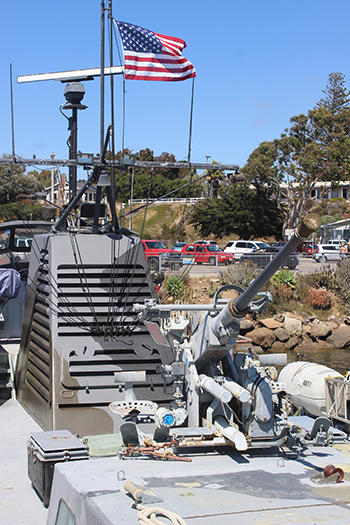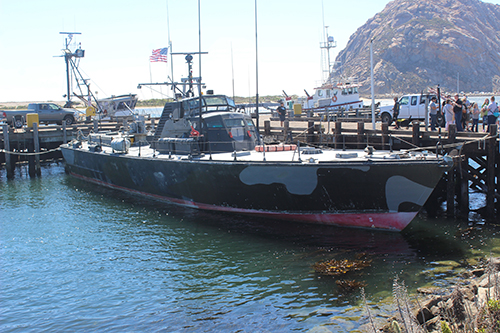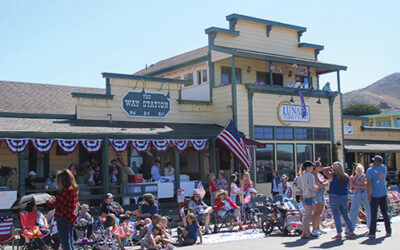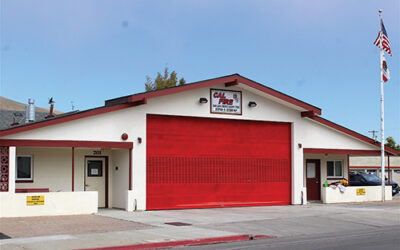The PTF-26 (short for “Patrol Torpedo Fast” is tied up to Morro Bay’s South T-pier.
A famous Vietnam veteran has been tied up to Morro Bay’s South T-pier for several weeks now, getting ready for a trip through the Panama Canal and the Caribbean Sea, and up the Mississippi River System to a new home in Kentucky.
Morro Bay’s Larry Newland has been watching over the PTF-26 (short for “Patrol Torpedo Fast” boat) for the owners, the Seaman’s Church Institute (SCI) in Paducah, Ken.
“This is similar to the more famous PT boats of World War II,” explains Newland while standing on the wide, rear deck of the Navy war ship. There was only 26 of these made and this was the last one, number 26, he adds.
It’s also one of only four that were made with aluminum hulls — the other 22 were wood — and it’s the last PTF boat still afloat anywhere in the world, making it not only historically valuable but also exceedingly rare.

“In 1960-62,” Newland says, “the Navy needed a smaller boat, something like the PT boats from World War 2.”
The PT boats were made famous by then-Lt. John F. Kennedy, who commanded PT-109 in the South Pacific during the war, for which he gained fame and rode it to the Presidency.
Most of the PT boats were stripped and burned in Manila Bay after the war, Newland says, and only two or three PT boats survived. With the Vietnam War just gearing up, the Navy needed a new, fast attack boat.
“The U.S. Navy went to the Norwegians, who had these ‘Nasty’ class boats,” Newland says. “The Norwegians have a small boat navy not a big draft navy, there’s no cruisers or battleships. They have a lot of what’s called ‘littoral’ or close-to-shore boats. The Navy was interested in the Nasty [Tjeld in Swedish] class boats, which were 80 to 85-foot wooden boats that looked a lot like the PT boats.”
Several other countries had the vessels in their Naval fleets, including Germany, England and Turkey.

The U.S. initially ordered a dozen of the Nasty boats from Norway and then got a license to build them here in the U.S. down in New Orleans. They traded out the engines for more powerful Napier Deltic diesel motors that were used for gunboats, tanks, trains and big trucks, and were made in Britain. Each Napier Deltic engine produced 3,100-horse power, enough to make the boat hydroplane when it got up to speed, 40 knots with a top speed of 51 knots.
Those engines have since been replaced with twin Detroit 1671 engines (a 16-cylinder block each at 71 cubic centimeters). She also carried 3,000 gallons of fuel.
The boat carried a crew of 19 and the sleeping quarters below decks hint at what must have been tough duty aboard the gunboat. Narrow halls, tiny rooms and short water tight doors give the impression that anyone doing duty on one of these boats would best be short and skinny.
The bunks are stacked three high, the galley was a tiny space and the heat, even on a cool Morro Bay summer day, could easily become unbearable.
“This was built for 18 to 20-year olds,” Newland says, while cautioning a reporter to watch himself. “There’s a lot to bang your head on down here.”
“In 1968,” Newlands says, “this boat was made. It was the last one made and was sent to Da Nang.”
The PTF-26 spent about a year in Vietnam, ferrying Special Forces troops into shore, and first softening up the enemy with its various canons and machine guns.
“This wasn’t a rescue boat,” Newlands explains. “This was a go-get-them boat.”
The Navy made other changes to the design including lengthening the hulls to 95 feet, beefing up the engines and generators and arming them, heavily.
The PTF-26 still has its 40mm Bofours cannon (now inoperable) mounted on the rear deck. When in action, she had twin .50-caliber Browning machine guns mounted one on each side, and a 20mm Oerlikon anti-aircraft gun mounted on the fore deck. She was truly a war machine. The big gun weighs 4,000 pounds.
“Bofours is a Swedish-German company,” Newlands explains, “that’s been making cannons since the 1600s.

The Morro Bay Maritime Museum has a whale harpoon cannon on display that was made by the same company. “They are still used today by modern Navies.”
After its brief service, the boat went to San Diego and then to Point Hueneme. In 1986, the Navy surplused the boat and sold it to the Liberty Maritime Museum and it became a training vessel for the local Sea Scouts.
The Liberty Maritime Museum is in the Sacrament Delta, so the boat’s been in fresh water since the mid-1980s. Now the boat belongs to the Seaman’s Church Institute.
Newland says the SCI folks are slated to come to town Aug. 6 and get the boat ready for a trip down to Ensenada where it will go into dry dock for repairs.
“It’s a 52-year-old boat,” Newland says. “It needs a lot of work.” There it will be loaded onto an ocean-going cargo ship for a trip through the Panama Canal and the Caribbean Sea to Louisiana at great cost. Newland says it costs over $80,000 to ship a vessel by cargo carrier from Ensenada to Miami, which is how most of the large yachts and sailboats get from one side of the hemisphere to the other.
From there it will be side-tied to a tugboat and ferried up the Mississippi River system and up the Ohio River to Kentucky. “The Seaman’s Church Institute is a benevolent support group, a religious organization for Navy, Merchant Marines and mariners. This will be parked there and be a museum piece and training vessel. Chaplains will get boat handling training.”
Newland is hoping to catch a ride with the PTF-26 as it goes through the Panama Canal; something he says is on his bucket list. If nothing else, he’d like to catch up to the boat when it hits New Orleans and ride with it up the river to its new home.
Newland, who was a driving force in establishing the Morro Bay Maritime Museum for some 27 years, still carries a passion for all things maritime, though he recently retired from the museum board.
He’s down at the boat on most days for at least a little while. He emphasizes that PTF-26 is not open for tours, but there is a plaque mounted on the side that gives the history of the vessel.
People are welcomed to check out the historic warship, which will probably leave Morro Bay sometime from Aug. 20-24.



